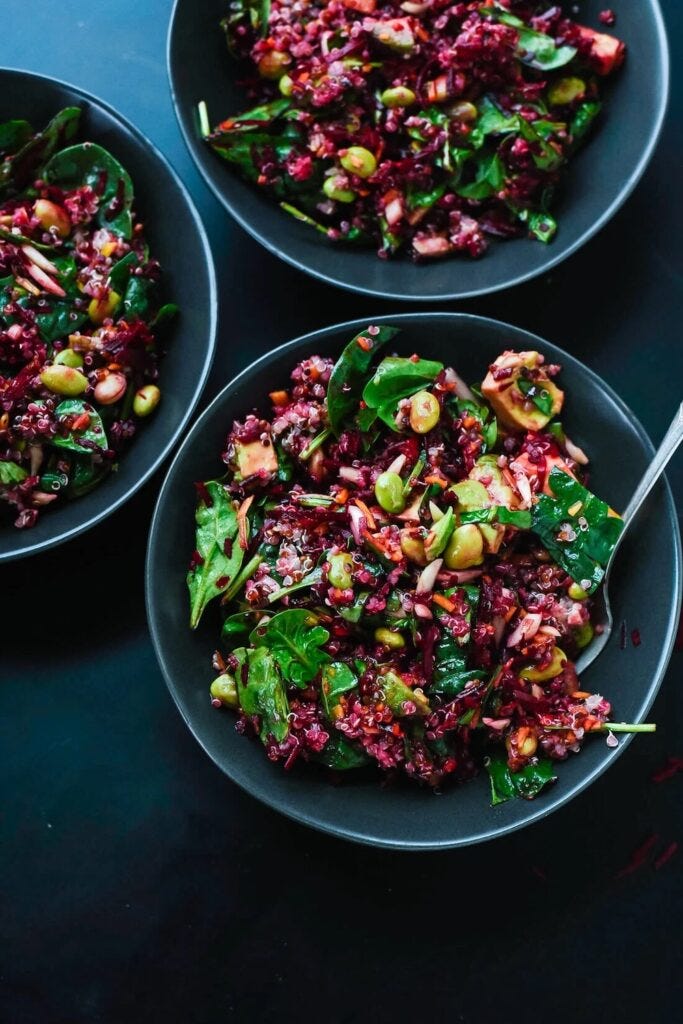10 easy meals for when your hormones are causing havoc
PLUS! 5 facts about perimenopause that will shock you
BeWell | The Midst beauty, style & wellness newsletter
Exclusive for subscribers to The Midst Substack
September is Perimenopause Awareness Month, so we’re dedicated to delivering you the info you need to get through this thing we call peri (although some of us call it hell). Be sure to check out The Midst’s Instagram for regular tips, and don’t miss our events for live conversations with experts on this important topic.
5 surprising facts about perimenopause
The average length of perimenopause is about four years, but it can last up to eight years. If we’re going to be living in this state, we better get our facts straight. Here are five symptoms that may surprise many of us, myself included:
Peri can feel like electric shocks. Since estrogen affects how our nerves function and is linked to neuropathic pain, strange tingles under the skin called Electric Shock Sensations (ESS) can occur, often before a hot flash.
Peri can cause belly fat. Even if you’ve always been more of a “pear” kind of GAL, during perimenopause, fat will begin to move to your belly. (You’re not alone!)
Peri can cause depression. Major depressive disorder — even in women with no history of mental illness — can occur due to hormonal fluctuations, with estrogen being a key player.
Peri can cause joint pain. Estrogen helps to reduce inflammation in our bodies, so as estrogen levels drop during perimenopause and menopause, inflammation can increase, leading to more joint pain and stiffness.
Peri can cause body odor. All those hot flashes and stinky bacteria in our sweat — along with an increase in testosterone, which can lead to even more bacteria in sweat — can result in B.O. Lovely, huh?
Want more peri info?
Be sure to register for F#ck Middle Age: A Day in The Midst 2024 Conference on October 19!
Our first panel, hosted by The Midst’s very own Amy Cuevas Schroeder (@themidstlady), is dedicated to answering all of your peri/menopause questions, featuring:
Lauren Streicher, MD (@drstreich), clinical professor of obstetrics and gynecology at Northwestern University’s Feinberg School of Medicine, certified menopause practitioner of The Menopause Society, and the founding Medical Director of the Northwestern Medicine Center for Sexual Medicine and Menopause.
Rachel Hughes (@rachel.hughes.midlife), Head of Community at menopause health platform and provider, Alloy Women’s Health, leading support groups, webinars, and more for Alloy members.
Learn more about our conference on the-midst.com here.
BY SALLY DUFFIN, a U.K.-based health writer, registered nutritionist/nutritional therapist, and author of Natural Nutrition for Perimenopause.
10 easy meals for when your hormones are causing havoc
We’ve all been there. It’s late in the day, you’re tired and hungry and the thought of planning a meal is just too much. Snacks and soda promise a quick energy kick, but long-term, you know they’re not a great strategy.
So what if there were quick and easy meals that would boost your energy and help balance your midlife hormones? Step forward 10 of the best hormone-balancing meals.
Each one is a great source of fiber, protein, and healthy fats. These are essential nutrients for regulating blood sugar, optimizing energy levels, mood balance, skin health, and more as we go through perimenopause. They’re free from artificial sweeteners, additives, colorings, and thickeners. And you can make most of them in large quantities and store or freeze the leftovers.
I purposefully haven’t listed them as breakfast, lunch, or main, because you can choose to eat them at any time of day. Eggy porridge for supper? Go for it! Beef patty for breakfast? Bring it on! I invite you to get playful and see what happens.

1. Eggy porridge
This one is quite divisive: you’ll either love or hate it. I love it, especially if I’m home late from work and feel too tired for a larger meal. The squidgy texture and gentle sweetness are like a hug in a bowl.
How to make
Gently heat 3 tablespoons of oats, 1 tablespoon of ground flaxseed, and roughly 100-150ml of milk (whichever type you prefer and use more if you like it runny). When the porridge is almost ready, crack an egg into the mixture and gently fold it through. It will cook in 1-2 minutes. Top with a handful of flaked almonds, pumpkin seeds, and a drizzle of maple syrup.

2. Beetroot, leafy greens, and quinoa salad
Beetroot and leafy greens like arugula, kale, and watercress support estrogen detoxification pathways in your liver. Quinoa provides fiber and a little plant protein, but you’ll want to top this up with extra protein from chicken, turkey, a couple of hard-boiled eggs, or tofu. I prefer to roast the beetroot, but you could enjoy it raw if you prefer. Dress the salad with homemade lemon dressing.
How to make homemade lemon dressing
Whisk together 3 tablespoons of olive oil, the juice of 1 lemon, and 2 tablespoons of apple cider vinegar with the mother (the active ferment that gives ACV its health properties). Add black pepper and ½ a teaspoon of honey to taste. Store in a screw-top jar in the fridge for up to 5 days.

3. Orange soup
No, it’s not a fruit soup — the name comes from the gorgeous color of this dish. Butternut squash, carrots, and tomatoes are rich in beta-carotene, a plant compound that converts to vitamin A in your body. Carotenes and vitamin A are antioxidants that protect cells against the rise in inflammation triggered by falling estrogen.
To save time, buy frozen ready-diced carrots, butternut squash, and onions.
You will need
500g (2 cups) carrots, peeled and diced
500g (2 cups) butternut squash, peeled and diced
1 onion or a handful of ready-chopped onion
100g (2/5 cup) dried red lentils
250ml (1 cup) passata
1 litre (1 quart) vegetable stock
1 teaspoon curry powder
1 tablespoon olive oil or coconut oil
Melt the oil in a large pan and gently soften the onions. Add the carrots, squash, and curry powder. Mix well and let them fry for a minute or so. Add the lentils, passata, and stock. Cook until the vegetables and lentils are soft. Allow to cool slightly, then blend until smooth.
Or pop all the ingredients in a soup maker and let it get to work!

4. Garbanzo bean and spinach curry
Garbanzo beans contain phytoestrogens, plant compounds that help modulate the ups and downs of normal estrogen during perimenopause. They’re also packed with fiber and plant protein to boot.
This article was originally published last week on the-midst.com here.
Thank you for reading the BeWell newsletter!
X, Lauria, Head of Editorial & Content at The Midst
The Midst is a woman-owned business on a mission to empower women in midlife.








Love this, and tempted to try the eggy porridge!!🥣 XO
There are no foods that “balance hormones” . Hormone levels will not change after eating these foods. Eat these recipes if you like them, but there is no hormonal benefit.